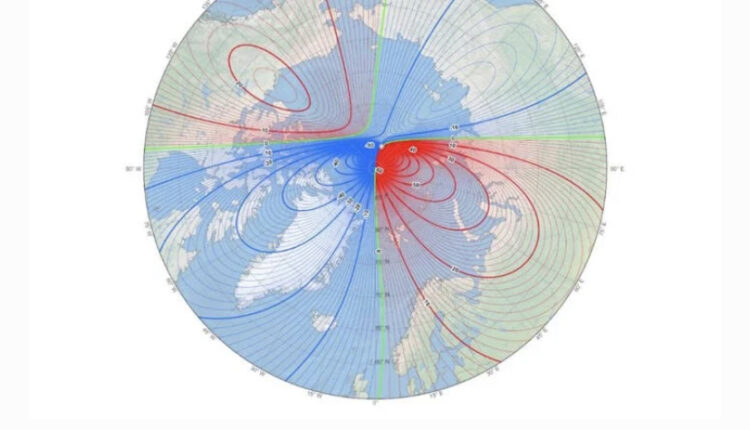The magnetic North Pole is not where it used to be.
Scientists have measured its location since James Clark Rose first identified it in Canada’s Nunavut territory in 1831.
The Pole, which has moved several kilometres every year in the past, is racing at an unprecedented rate towards Siberia during the past past few decades.
Researchers from UK and Denmark claim to have uncovered the cause of this rapid shift. Two writhing lobes of magnetic force are ducking it out near Earth’s core, reports a magazine Popular Mechanics.
Our planet’s protective magnetic field, which keeps deadly cosmic rays at bay and serves to orientate our navigation systems, is generated in Earth’s outer core, more than 2,900 km below the crust. “You have got these sorts of swirling hot masses of molten iron, bubbling and moving around “ says Phil Livermore, PhD, a professor of geomagnetism at the University of Leeds.
These molten blobs of iron generate an electrical current, which in turn creates a magnetic field. In regions on Earth’s outer core where magnetic force is strongest, the magnetic field pokes out. “That is what we call a flux love,” Livermore says. These shifting lives of magnetic force determine the location of the planet’s magnetic poles through a magnetic tug of war.
Thanks to geological samples of magnetised rock, we know that the magnetic poles have periodically drifted and enliven flipped throughout a earth’s history. Polar reversals occur when Magnetic North and South switch places over the course of thousands of years. (Imagine a north-pointing compass arrow facing Antarctica).
This happens roughly every 200 000 to 300 000 years, with some exceptions. The latest reversal occurred around 780 000 years ago, so technically, we are overdue for a switch.
Magnetic North’s recent migration is happening faster than at any other time since it was first measured in the 19th century. The acceleration began in 1990, when the Magnetic North Pole went from moving on average about 15 km ear year to as many as 60 km by 2005.
In an effort to understand why it is happening, Livermore and his team created a series of computer models using data from ground observatories and satellites, and found that between 1970 and 1999, the flow of magnetic field at the surface of Earth’s outer core changed. These changes were also reflected in the strength of the magnetic field.
Until the 1999s, the Magnetic North Pole was controlled by two fairly balanced patches of magnetic field beneath Canada and Russia, Livermore says. Then the patch under Canada started to stretch out and become weaker, shifting the balance of power to the patch in Siberia.
To Joseph Merry, PhD, a professor of geology at the University of Florida in Gainesville, who was not affiiywithbthe study, it is as simple as playing with magnets: “if we remove all the maths and just thinks about how magnets work, it is very straightforward,” if two magnets are pulling on an object, and one magnet weakens, the object drifts towards the other magnet.
The wanderings of the Magnetic North Pole have significant consequences for global navigation. Every five years, agencies in the US and UK produce the World’s magnetic model which lets you calculate your position based on Mahnetic North Pole’s location.
Anyone who uses a compass – fromMilitary navigators to commercial airline pilots – relies on the model to pinpoint their location around the globe. As the Magnetic North Pooe slides across the Arctic, the model becomes less accurate, which poses a problem for anyone requiring an ultra-precise reading.
These errors are more pronounced an latitudes above the 55 degree parallel, including places such as parts of Scandinavia, Greenland, Russia, Canada, and Alaska. To account for the accelerated motion, the agencies had to release and emergency update to the 2020 World’s Magnetic Model a year early.
Researchers are racing to understand what Magnetic North’s movement may mean fir the magnetic field as a whole. Livermore does not thinks that a polar reversal is inminent because, while the magnetic North Pole is sliding around, the global structure of Earth’s magnetic field has remained relatively stable.
The greatest challenge in studying Earth’s magnetic, Livermore says, is making sense of what is happening in Earth’s outer core. “ It would be great if we could somehow invent a device to go visit Earth’s core, to have a look at what these lobes of molten iron are doing and see how they interact with the magnetic field,” he says.

